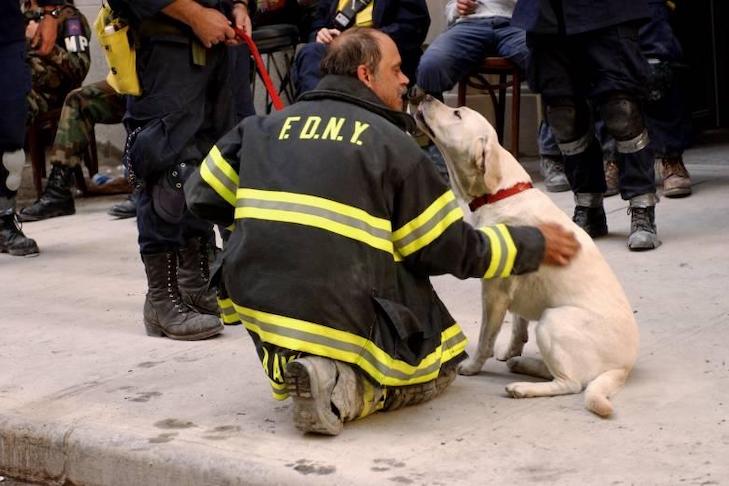
On the morning of September 12, 2001, Susan Cohen was going to her job at New York City’s Animal Medical Center when she saw a search-and-rescue German Shepherd Dog being rushed into the emergency room. The dog had been overcome by toxic fumes at Ground Zero, and needed medical help fast.
As AMC’s director of counseling, Cohen understands how deeply people love their dogs. She has spent a lifetime studying the human-animal bond. Nevertheless, she was not prepared for what she saw when she went later to check on the dog’s condition.
“I looked in, and was just dimly aware that there was a person in the cage. But I thought it was a tech, adjusting something,” she says. “Then I realized there was a fire-fighter in the cage, dressed in all his gear, covered in ash, sound asleep, with his arms around this dog. The man’s head was on the dog’s shoulder.”
Both were soon back in action, but Cohen could not get the image out of her mind. She was moved by the man’s devotion to his canine partner, but at the same time she realized the firefighter needed to be there for his own sake as much as the dog’s. They had been through hell together, and the experience had forged an unbreakable bond.
“When you have a horrific and unusual experience like that, you get very close to whoever went through it with you,” says Cohen, whose specialty is helping people deal with the loss of a pet. “Having spent a long time with somebody, having gone through significant events, feeling that you were rescued by, or that you rescued someone, will form a very tight bond. …Not just that we went through this together, but that we saved each other.”
As time went on, Cohen began to see that this phenomenon was widespread. “A number of people told me that ‘I lived nearby and watched the horrors out there. The dog kept me sane,’ she says.
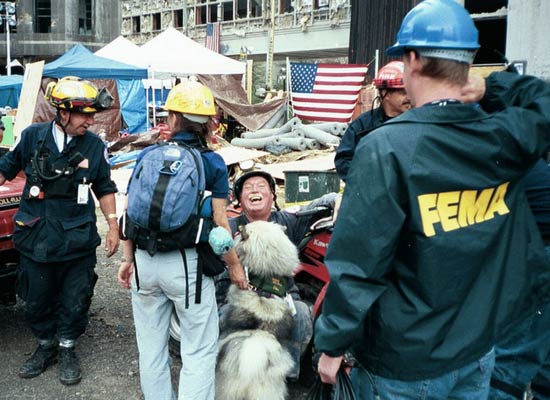
![]()
Safe Harbor
“My dog was a source of calm in what was a brewing storm in my own head. He was my Rock of Gibraltar among turbulent waters,” says Joan Esnayra, Ph.D., president of the Psychiatric Service Dog Society, a nonprofit organization devoted to advocacy and education about canine support for people with mental illnesses.
The terrorist attacks plunged Esnayra, who has bipolar disorder, into the worst manic episode of her life, one that believes might have killed her. She became erratic, depressed, and suicidal. Her Rhodesian Ridgeback service dog, Wasabi, couldn’t prevent her mania – a dog is only one facet of the therapy required to tackle serious mental illness – but she believes things would have been much worse without him.
“I might have acted on more impulses if he wasn’t there,” she says. “Having the burden, and I mean this in a positive way, of having a dog with you 24/7 means that you can’t get up in the middle of the night and just decide to go for a drive across the state, because you have to think about the impact this will have on your service dog. It keeps you a little more responsible.”
After 9/11, therapy dogs would also gain increased acceptance, due in part to their highly visible role in helping people affected by the attacks. The Delta Society, for example, reports that the number of its teams doubled, from 4,000 to 8,000 nationwide, between 2001 and 2006.
“A dog’s gift is that powerful, magical ability to help us heal,” says psychologist Nanette Winter, who brought her therapy dog Gus to help the families and friends of WTC victims. “As a city and as a nation, that’s what we needed after 9/11”
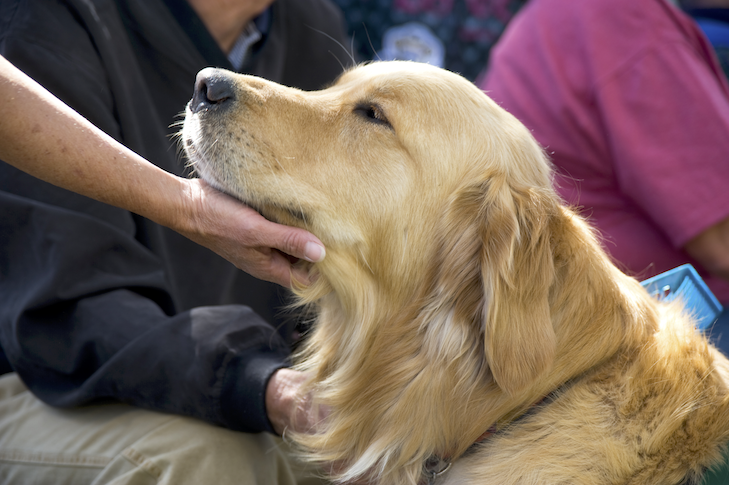
![]()
Stronger Ties
“Clearly the insecurity that 9/11 forced upon us has brought people closer to their pets,” says Herbert Nieburg, Ph.D., a psychologist who in 2001 was in private practice in Westchester, New York, and was also the chief psychologist for the New York Guard, coordinating mental health care for Ground Zero military personnel. “Psychologically, what happened that day was this major insecurity, a breach of complacency that we had.”
Scientists probing America’s mental health support his observation. They have found 9/11-related spikes in heart attack rates, smoking, drinking, marijuana use, and signs of post-traumatic stress disorder. An expert in dreams even reported on a small study suggesting that people had more nightmares.
“I think that the only beings that were able to give us solace and consolation, in terms of their unconditional love, were our pets.” says Nieburg.
Many people recall hugging their dogs as they watched the chaos on television or waited for loved ones to come home. For others, a pet may have become the only thing they could cling to in the wake of the tragedy, or a living reminder of someone who had died. Still others decided to get a dog for the first time.
“The motivation was partially security, but mostly companionship, and feeling safe, feeling that they had bonded with someone,” says Nieburg, author of Pet Loss: A Thoughtful Guide for Adults and Children (HarperCollins, 2003). “What we’ve seen overall is an increased awareness of the value of pets.”
This deepening of the human-canine bond had another effect: It made the already heartbreaking task of saying goodbye all the more agonizing, says Cohen.
Shortly after the attacks, she says, a man came to the AMC with a very sick dog. He had worked on a high floor in the World Trade Center, but had been off on 9/11. “I’ve lost all my co-workers, all my customers, my job, and now my dog is really sick,” he told Cohen. The thought of losing his dog – the only thing he had left in the world – was devastating.
Cohen had seen similar responses among many who went through 9/11 with a pet. She has observed that the date comes up often when people are making end-of-life decisions for their animals.
“If you feel somebody rescued you, you want to pay back.” she says. “But now, you’re faced with the thought, ‘I can’t save him,’ and it’s very painful.”
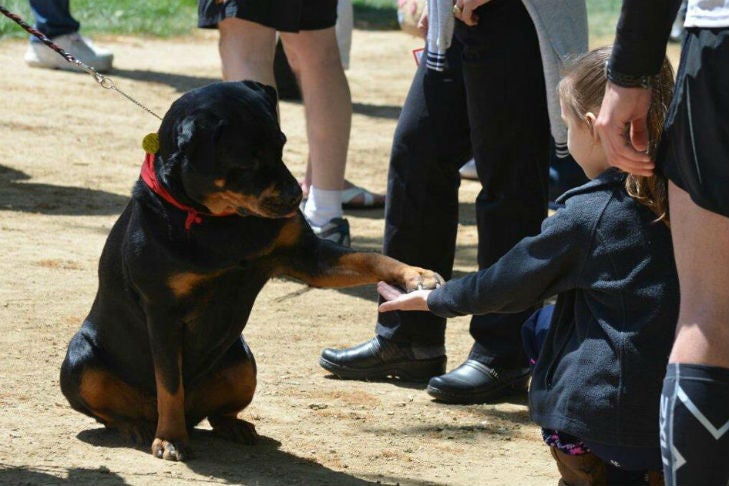
Shock Absorbers
While therapy dogs have been around for three decades, their work with the families of 9/11 victims fostered a new appreciation of the unique canine capacity to soothe the human soul.
About 100 therapy-dog teams worked at the Family Assistance Center at New York’s Pier 94; more volunteered at other sites where families gathered, such as Liberty State Park in New Jersey. These were places where relatives of the missing came for help, first in finding their lost loved ones, and then in coping with the grief of knowing that person was never coming home.
Teams came from all over from all walks of life, from philanthropist Karen LeFrak and her magnificent standard Poodles to people with pet pooches who just have a knack for bringing a smile to a sad face. All the canine counselors were certified therapy dogs, trained and tested for their ability to reach the bereaved as no human can.
“People don’t talk to other people. But they’ll talk to you when you have a dog,” says Ursula A. Kempe, president and CEO of Therapy Dogs International, Inc. (TDI), Flanders, New Jersey, a volunteer organization dedicated to regulating, testing, and registration of therapy dogs and handlers.
Kempe, who was one of the founders of TDI in the late 1970s, worked with her therapy dog Wusel in New York after 9/11. Once the dog broke down the initial barriers, Kempe says, the handler would direct the person to a psychologist, clergy, or other professional.
“Basically we walked around and waited for people to come to us,” recalls Deborah Kennedy, a retired New York City police officer, who volunteered at Pier 94 with her 100-pound German Shepherd Dog, Jennie. “I met one lady who had lost two kids, a son and a daughter, at the World Trade Center. She walked up to us and threw her arms around Jennie, and started to tell me her story. … She had had Shepherds in the past, and she just related to the dog. She told me her story, told me about her kids. Then we said goodbye and went on our way.”
In many cases, the grief was too deep for words, and that’s where the dogs played an even more valuable role.
“I can’t tell you how many times people just grabbed the dogs and bawled their eyes out,” says Joanne Silver, a handler with Bright and Beautiful Therapy Dogs, Morris Plains, New Jersey, who brought her Chesapeake Bay Retrievers Coco, Lucy, and Jeannie to Liberty State Park.
Relief workers were also grateful to have them around.
“They found a lot of comfort in the fact that the dogs were there,” says Silver. These professionals would frequently feel overwhelmed by the avalanche of suffering, and would stop to pet or play with the dogs to take their minds off of the sorrow surrounding them. “It was rough-going down there.”
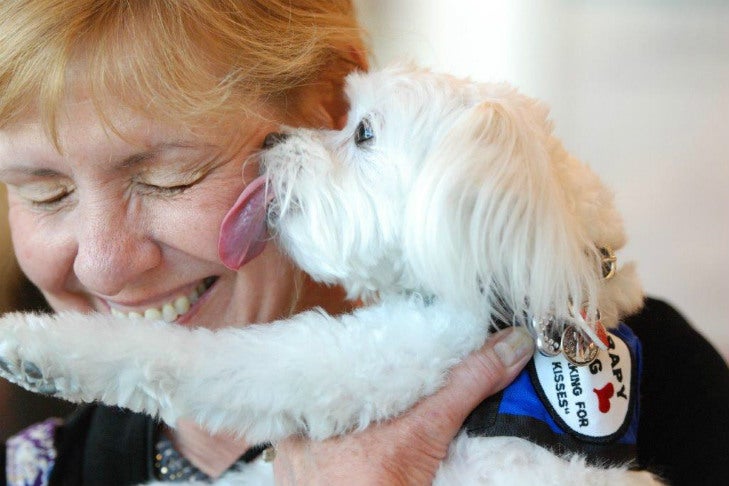
Silver, who has been setting up hospital and children’s therapy-dog programs since 1989, says that in the five years after 9/11, she perceived a growing acceptance of animal-assisted therapy.
“The world looks at these dogs a little differently now,” Silver says.”There was a hospital that I had been trying to get into for 12 years, but they didn’t contact me until after 9/11. There’s more respect for the programs”
Therapy dog groups also learned another important lesson – that the leap from a hospital setting to a disaster site is not easy. “There was a lot of sadness, grieving,” says Kempe. “Dogs sense all kinds of things. Grief and stress from the person – that goes into the dogs. Not every dog can handle it.”
For some, the constant barrage of misery was too much, and they started to show signs of distress, or to shut down and refuse to work. So, with input from handlers, TDI has developed a test and additional training protocols to prepare teams to deal with future catastrophes, says Kempe.
For this line of work, dogs must be tough, but they also have to retain incredible sensitivity to human emotions. Kennedy saw her hard-working Jennie exhibit this talent during their most challenging assignment — accompanying people on the boat from the assistance center to a viewing platform at Ground Zero.
“There was a little boy on the boat. He had lost his sister and was terribly upset,” recalls Kennedy. After a few minutes, the team moved on. Later, Kennedy sat down for a break and, for a moment, took her hand off Jennie’s leash. “All of a sudden, she was gone,” says Kennedy. She looked around until her eyes found Jennie’s familiar form. The dog had sought out the sad boy, and was sitting quietly next to him as he stroked her fur.
“I thought, wow, she picks up on people and what their needs are. There was something about that little boy,” Kennedy says. “I can tell you a hundred stories like that, of people along the way.”
Witnessing this remarkable canine empathy in the worst of times encouraged some people, who had never had pets, to seek out full-time canine companions.
At one WTC memorial service, Silver recalls that Lucy spent much time brightening the spirits of two young brothers who had lost their father. In the next few years, Silver and Lucy would run into them at subsequent gatherings, and each time, the boys greeted the dog like an old friend.
Five years after 9/11, Silver says, the boys’ mother called to say that she has gotten them a dog of their own.

